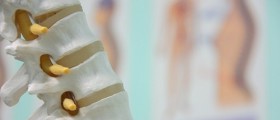
Degenerative disc disease
Certain conditions can cause damage to the spine as they place a lot of pressure on the spinal cord and nerves. Due to this pressure a person may experience severe pain and can even have his or her nerve functions affected. Osteoporosis is one of these conditions. This condition is characterized by the breakdown of tissue that is responsible for the protection of joints. An abnormal bulge or the situation where the spinal disc brakes open is called herniated disc. The narrowing of the spinal canal or spinal stenosis is another condition that can damage the nerve function and the spinal cord. Age is one of the main causes that lead to degenerative disc disease in most people. Degenerative disc disease occurs due to the break down or degeneration of the spinal discs. The loss of fluid also occurs because of old age. Without sufficient amount of fluid, the disc can no longer have the role of shock absorber and the spine will no longer be able to flex and twist as it used to. The discs become thinner as well and that can lead to the distance between two bones that the spine consists of. Age also leads to the development of small tears and cracks in the outer layer of the disc. The outer layer is also called a capsule. These cracks make the nucleus, which is the material located inside the disc, able to leave the disc. When that happens, the disc will protrude, break open or even break into small pieces.Certain people are more prone to developing these changes. Those who use tobacco and construction workers are more likely to suffer from this condition than other people. Apart from them, an obese person is more prone to degenerative disc disease due to the extra pressure that is being placed on the joints. The degeneration process can also begin all of a sudden, for instance when a person suffers from a fall and experiences a sudden injury.
The signs of degenerative disc disorder that occur most often are back or neck pain. It is not uncommon for a person to experience no pain at all. On the other hand, a person can suffer from severe pain that makes him or her unable to perform normal activities. The location of the disc that is being affected will determine the area of pain. The pain will only become worse when certain actions like bending or reaching up are performed.Physical therapy for DDD
When a patient starts experiencing the symptoms of degenerative disc disease, the doctor will advise him or her to make the muscles of the back and neck stronger. Strengthening of core muscles is vital as well. If these muscles are stronger a person will have better support of the spine and that will significantly lessen the pain. However, sometimes the strengthening alone is not enough and the patient will need to go on physical therapy. Both passive and active treatments are included. Passive treatments have the goal of making both the patient and his or her body more relaxed. Passive therapy is mainly prescribed for those who suffer from acute pain. Many passive treatments are available and the therapists will decide which one is best suited for the patient. It is not that uncommon for the patient to receive more than one type of treatment at the same time.
Deep tissue massage is one of the passive treatments that are used most often. The massage of the deep tissue focuses on relieving the tension in the muscles and getting rid of the strains. The tension usually develops due to stress that more and more people face every day. Spasms in the muscles are possible as well but they will also be treated with deep tissue massage.
Another form of passive treatments are hot and cold therapies. Heat is good because it will better the circulation in the affected area and the cold is used to reduce inflammation and pain.
Apart from these two treatment options, another one called spinal fraction is used quite a lot as well.


-Causes,-Symptoms,-Diagnosis,-Treatment_f_280x120.jpg)













Your thoughts on this
Loading...